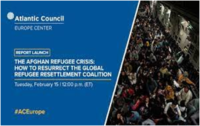
Author: Atlantic Council.
Year: 2022.
Publisher: Research Gate.
Taliban War Background
The Afghanistan conflict drew its roots to the invasion of the country by the Northern Alliance funded by America, and other powers in the past, such as the Soviet Union. The United States of America, provoked by the threat of Al Qaeda led by Osama Bin Laden harbored by Afghanistan, started the invasion initially in a proxy war model. The Central Intelligence Agency collaborated with an alliance of mostly northern Afghani militias termed the Northern Alliance. It was led by notable individuals such as Masoud Ali and General Rashid Dostum.
The alliance saw initial success with the capture of Kabul by late 1999 with the help of the Americans, the Taliban was forced to Pakistan. Despite warnings of disaster upon interfering members of the Northern Atlantic Treaty Organization undertook a quest for national rebuilding. Emotions and a secret modern arms race were the triggers as each nation wanted to test its might through perceived harmless and short deployments. The Taliban was beaten but still active, got backing from mostly Shia Islam nations, and gradually returned as a cohesive guerilla force (VOX news, 2018).
Northern Atlantic Treaty Organization and its superior armies soon were caught up in a proxy war that saw their perceived allies to be their enemies in terms of support to the Taliban. Accusations of support from nations such as Pakistan, which hosted refugees and had a terrorist problem, were common all over world media houses. Frustrated and led by the world leader of the alliance, the United States’ perceptions shifted to a fast withdrawal due to collateral damage. The masses started a perception of war to keep the elite who owned factories happy.
Leaders in the alliance countries were voted in and out based on their willingness to solve the issue. In the United States we saw three leaders come in and out on the basis of the issue. An issue bigger than the Vietnam war, it all came down in the transition between Donald Trump and current US President Joe Bidden. The withdrawing alliance forces who were under resourced left an easy picking Afghan army for the Taliban. The Taliban swept the rural areas and as more alliance troops withdrew, cities such as Kandahar fell despite the readiness of Afghanistan troops just like the defeat of United troops to the Demilitarized zone by the Chinese and Koreans. In the words of General Douglas Mac Arthur, ‘The enemy of the shadow took the land by surprise and it was all dark’. Kabul the capital fell to the Taliban after two decades of combating the force.
War: What is it good for?
The article focuses on Afghanistan due to the ongoing global conflicts as well as major historical events such as the Vietnam and Afghanistan-Soviet conflict. The authors intend to build a future global resettlement coalition applicable to all scenarios. Thus, the Afghanistan ongoing crisis is a starting point and a model for other cases such as the Russia-Ukraine conflict. The events of the fall of Kabul were witnessed on sets as well as in the internet by millions if not billions of individuals. Unlike the fall of Saigon, it will forever be reality in our minds.
The first and most devastating consequence of war is death and displacement be it voluntary or forced. During the evacuation we saw US President Joe Biden state that only United States embassy staff would be evacuated due to safety. The statement did not guarantee the safety of the ordinary Afghani who were in reality occupied without their consent. Many flocked to the borders and airports out of desperation and a guarantee of their safety by the occupying alliance.
Personally, I blame the alliance for turning the war to an elitist project rather than prioritizing the stability of the Afghanistan economy and safety of the population. The regional neighbors and the United Nations are equally to blame in their monitoring capacity as well as negotiation capability. The alliance and mostly the United States took the responsibility of peace and security of the Afghan people for fulfilling their own local and global ambitions. Thus, all global and regional partners have responsibility for the Afghan refugees and their resettlement.
The Afghan refugee response has seen good crisis response mechanism. United States has been a leader in accepting refugees and providing a withdrawal mechanism despite initial confusion. The states got to the point of an open border policy with the Afghanis, so did the United Kingdom, Canada, Australia and regional neighbor Pakistan. Resettlement was global from Qatar in Asia, Argentina in South Africa and Uganda in Africa.
Statistics of the global resettlement effort are as follows; United States evacuated an estimated 82 000 individuals and increased resettlement capacity to 60,000 individuals. The Afghan Relocations and Assistance policy took an estimated 20,000 individuals. Canada has increased its Afghan refugee capacity to 40,000 individuals as well as 3200 individuals in Australia. Smaller countries such as Uganda have also taken refugees. Pakistan and Iran have the largest bulk with traditional United Nations Refugee centers to host families.
Opportunity for Multilateralism in Refugee Rights?
Current and past humanitarian crisis and emergencies have necessitated a resettlement global coalition based on the principles of multilateralism. President Biden has been iconic on his acts in Afghanistan as a global leader which reminds us of Richard Nixon in the fall of Saigon, Vietnam. Many world countries have been demotivated in global humanitarian actions and thus it might be difficult in forming such a global coalition. The collapse of the Northern Alliance Treaty Organization’s mission Rebuild Afghanistan is an example of a demotivating factor.
The coalition’s objective would be to resettle refugees in an emergency situation such as Saigon and the fall of Kabul. The author of the article proposed that the United States should take the lead in creating such an organization but in my opinion I would prefer Canada due to its hospitality. The coalition should also include the 27 member countries included in the United Nation Human Rights charter. The structures of the coalition should be adapted, documented and followed up by regular documentation.
The resettlement coalition objectives should be to identify the vulnerable, internally displaced as well as international citizens in a conflict scenario. Through analysis and voluntary mechanism, the displaced can be resettled globally. To migration experts reading the analysis such as International Organization for Migration, it is up to you to facilitate the multilateral resettlement mechanism. Afghanistan as well as Ukraine are a portrayal of how conflict can disrupt normal lives and force many to seek asylum or refugee.
‘Preparation is the better key to shielding or reducing the impact of a disaster whether in Ukraine or Afghanistan.

Benedict Kuol is a GRDFT Global Compact for Migration graduate as well as a finance major from Strathmore University. He is a passionate writer and loves his role as GRDFT research intern.
